Selecting the ideal LED lighting system for sports facilities or gyms is a complex task, as it involves balancing multiple factors to achieve optimal performance. On one hand, a sports stadium requires a lighting system that ensures standardized brightness and minimizes shadows to provide a clear view for players, officials, and spectators. On the other hand, facility owners are increasingly concerned about reducing energy consumption for both economic and environmental reasons.
The key to meeting these diverse needs lies in leveraging the advanced features of modern LED lighting technology. LED lamps are designed to deliver high-quality illumination while being energy-efficient, which translates to lower electricity bills and a reduced carbon footprint. This is particularly important for facilities like baseball and softball fields, where both the quality of lighting and energy savings are crucial.
To navigate this process effectively, it is essential to understand the intricacies of LED lighting solutions and their application in sports settings. This comprehensive guide will walk you through everything you need to know about selecting and implementing the perfect lighting layout. From understanding national standards and regulations to discovering insider tips, industry secrets, and practical tricks, this guide provides an in-depth look at how to optimize your lighting system for both performance and efficiency.
Table of Contents
ToggleLighting Solutions for Baseball Fields and Softball Stadiums
Types of Lighting Used
Understanding the various types of lighting fixtures is crucial for effectively illuminating baseball fields and softball stadiums. Choosing or replacing lighting involves selecting the appropriate fixtures based on their characteristics and performance. Below is an overview of the different types of lights commonly used in these sports venues.
High Power Flood Lights
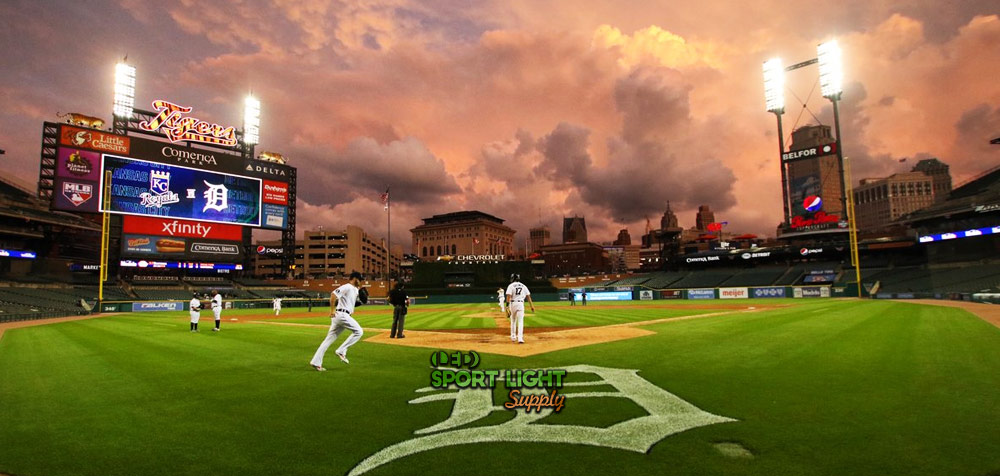
High power flood lights are widely used in baseball fields for their ability to cover large areas with a broad beam of light. These fixtures are ideal for illuminating the infield and surrounding areas, offering even light distribution that enhances visibility. Modern high-power flood lights often feature LED technology, which provides excellent lighting performance and a high color rendering index (CRI). This technology helps to accurately represent colors and details on the field.
These flood lights are versatile in terms of installation, as they can be mounted on various brackets or supports and used in groups for optimal coverage. However, it’s important to consider their weight and ensure proper installation at elevated heights for safety and effectiveness. The integrated design of these fixtures typically includes LED modules, heatsinks, and shielding, which work together to produce uniform and efficient lighting.
High Power Spot Lights

In contrast to flood lights, high power spot lights are designed to provide focused, long-range illumination. They are especially useful for lighting up the outfield where visibility can be challenging due to the field’s size. The adjustable nature of spot lights allows for precise targeting of specific areas or players, such as highlighting the pitcher’s mound or a particular player in the outfield.
Spot lights can be mounted individually or in clusters of two, three, or more, depending on the lighting needs. They are ideal for addressing dimly lit spots and ensuring that all critical areas of the field receive adequate light. This targeted approach helps in enhancing the overall game experience by ensuring that every part of the field is well-lit.
High Mast Lighting
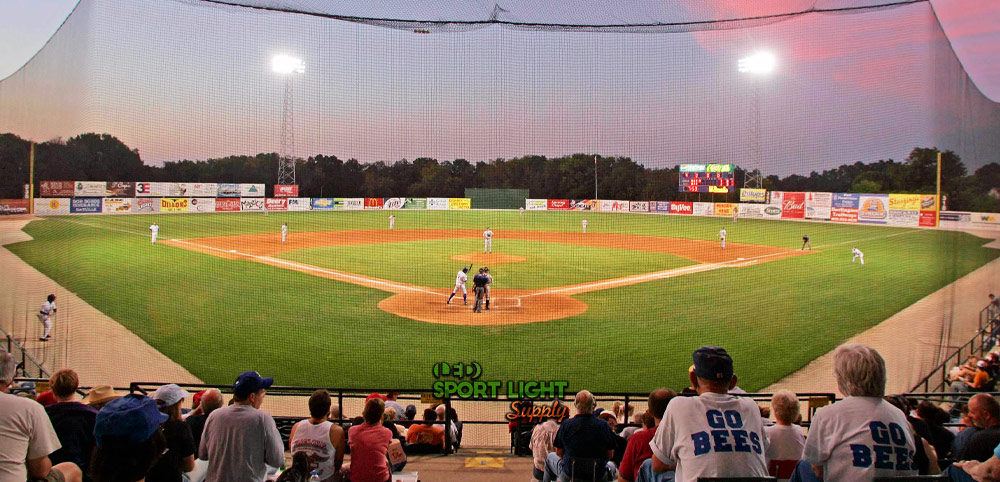
High mast lighting is essential for achieving effective illumination from great heights. This type of lighting is designed to cast light over extensive areas, ensuring that the field is uniformly lit and reducing glare. High mast systems are typically installed on tall poles or structures, which allow the light to cover large distances and improve visibility.
The goal of high mast lighting is to ensure that the light reaches the field indirectly, minimizing glare and providing comfortable visibility for players and spectators alike. Properly designed high mast lighting systems enhance the overall viewing experience by ensuring that light is distributed evenly across the entire field.
Outdoor Baseball Field Lighting Layout
Designing an effective lighting layout for an outdoor baseball field involves addressing several key factors to meet the standards set by Little League and Major League Baseball. The primary considerations include the number of light poles, their optimal placement, and the recommended pole height. Here’s a detailed guide to help you understand these aspects.
Number of Light Poles
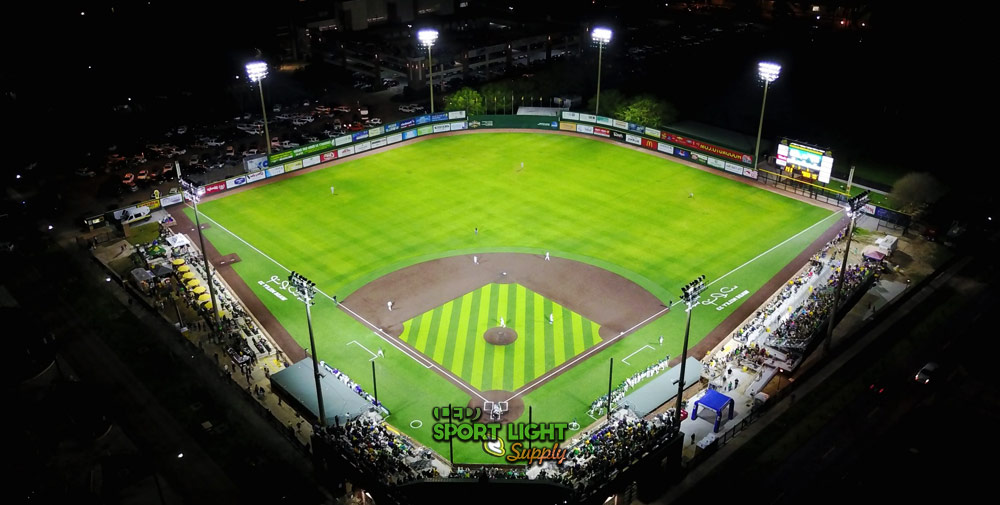
When designing the lighting layout for a baseball or softball field, the number of light poles required depends on the size of the field and the level of play. Common layouts include
| Pole Layout | Field Size Suitability | Usage |
|---|---|---|
| 4-Pole Layout | Suitable for fields with a radius between 200 and 250 feet | Often used for Little League games, providing adequate lighting for smaller fields. |
| 6-Pole Layout | Ideal for fields with a radius extending up to 300 feet | Common in slightly larger Little League fields, offering enhanced coverage and illumination. |
| 8-Pole Layout | Required for larger Major League Baseball (MLB) fields | Necessary to meet high standards for television broadcasts and large-scale events, providing comprehensive lighting. |
Typically, at least two poles are needed for infield lighting, while four to six poles are used to illuminate the outfield. The number of poles helps ensure that the entire field is evenly lit and meets the lighting standards for different levels of play.
Placement of Light Poles
The placement of light poles is crucial for achieving optimal illumination on the field.
| Lighting Area | Pole Positioning | Details |
|---|---|---|
| Infield Lighting | First two poles behind the home plate | Provides sufficient light for the batter’s box and infield area. Poles should be positioned so that imaginary lines extending from them to home plate intersect at a right angle. |
| Outfield Lighting | Third and fourth poles 140 to 170 feet from the field’s origin point and at least 40 feet behind the outfield fence | Focuses on illuminating the outfield area, ensuring even light distribution across the entire field. |
| Additional Poles | Remaining poles placed outside the field’s fence | For a 6-pole layout, poles should be positioned at roughly 20 degrees on either side of the field. In an 8-pole layout, place them at approximately 10 and 30 degrees on each side. |
The lighting fixtures that illuminate the infield should be inclined at a 25-degree vertical angle, while the lights for the outfield should have a minimum vertical angle of 21 degrees. This configuration helps to minimize glare and ensure even light distribution.
Recommended Pole Height
The height of the light poles is another critical factor that influences the quality of illumination.
| Usage Level | Pole Height | Details |
|---|---|---|
| Training/Recreational Use | 39 to 49 feet (12 to 15 meters) | Adequate for casual play and practice sessions, providing sufficient lighting for non-competitive activities. |
| High School/College Level | 49 to 65 feet (15 to 20 meters) | Meets the requirements for high school and collegiate games, ensuring appropriate visibility and coverage. |
| Major League Baseball (MLB) | 82 to 196 feet (25 to 60 meters) | Ensures that lighting meets the rigorous standards for professional-level games and television broadcasts. |
Indoor Baseball Field Lighting Layout
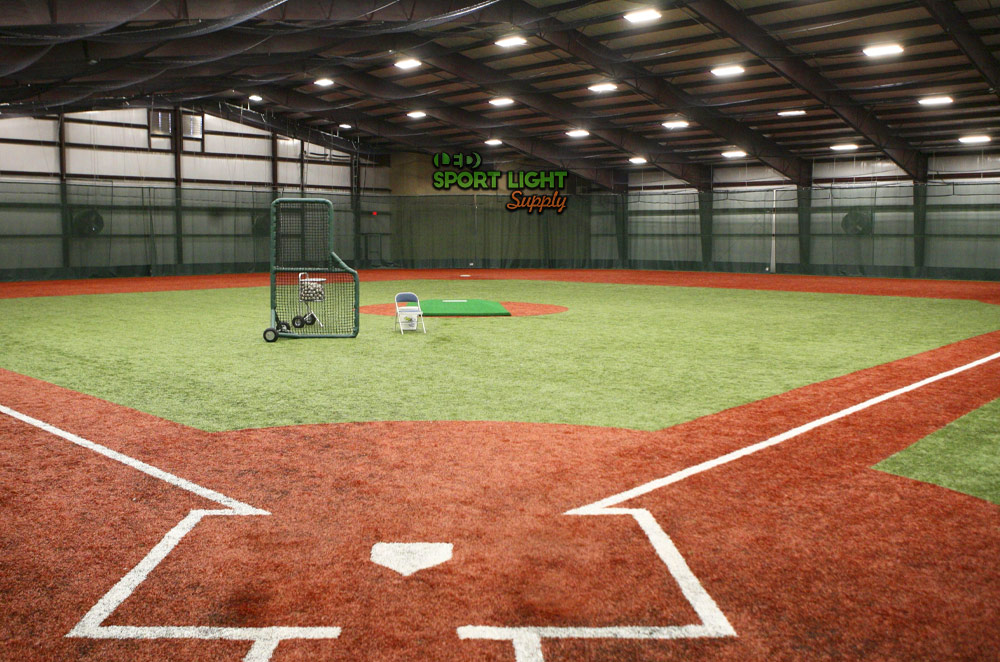
Designing an indoor baseball field lighting layout requires careful consideration of several factors to ensure proper illumination and adherence to lighting standards. Here’s a detailed guide to help you plan an effective lighting setup for indoor baseball and softball facilities, including batting cages.
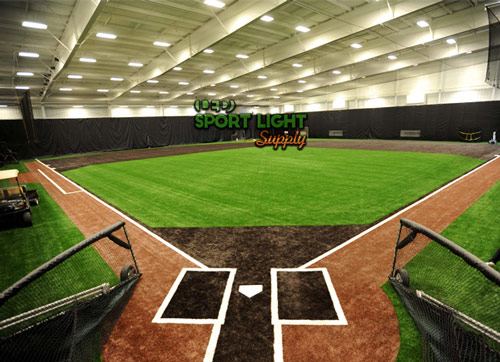
Ceiling Height
The ceiling height in an indoor baseball facility plays a significant role in determining the number and type of light fixtures required. Higher ceilings generally allow for more fixtures and affect the choice of fixture wattages.
For indoor athletic facilities, a minimum clearance of 60 feet is recommended for activities like softball. This height facilitates the use of high bay UFO lights, which are ideal for providing adequate illumination at greater distances. Additionally, protective nets may be necessary to shield the lights from potential damage.
Ceiling Type
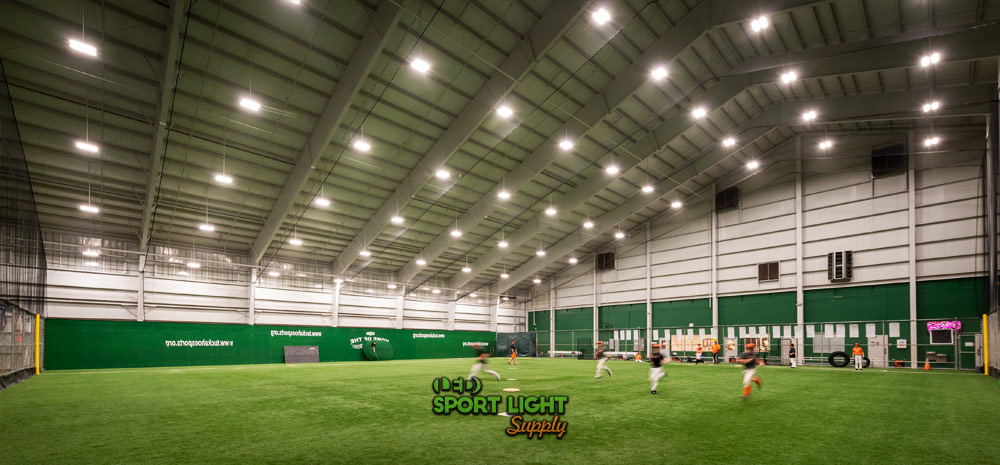
The type of ceiling in your facility influences the lighting design and installation:
| Ceiling Type | Details | Lighting Installation |
|---|---|---|
| Flat Ceilings | Common in modern indoor baseball and softball facilities, providing a straightforward setup. | Lights can be mounted directly or using a monorail system to accommodate additional luminaires, especially for distant spotlights. |
| Curved Ceilings | Found in some high school gyms or older facilities, where the ceiling shape can impact lighting design. | May require specialized mounting solutions or additional fixtures to ensure even light distribution. |
Field Size
A standard indoor baseball field or softball diamond may cover up to 30,000 square feet or more, not including additional training areas like batting cages. As field dimensions change, the lighting layout must be adjusted to maintain consistent illumination levels.
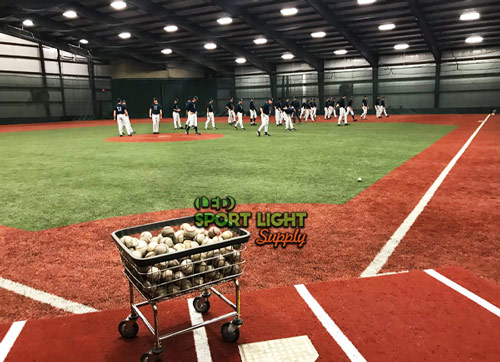
Spacing Between Flood Lights
The distance between each LED flood light should be determined based on the number of fixtures and their lumen output. Using the Space Height Ratio (SHR) provided by the lighting manufacturer, you can calculate the ideal spacing by multiplying SHR by the mounting height. This ensures that the lighting is evenly distributed across the field.
Distance Between Lights and Walls
As ceiling height increases, so does the distance between the lights and the walls. Ideally, the artificial light beam should hit the walls at a 30-degree angle to provide pleasant luminance contrast. The spacing between lights can be approximated by dividing the distance between each light in half.
Number of Indoor Batting Cage Lights
At least two flood lights are needed for each batting cage to ensure proper illumination. The number of lights required will vary depending on the number of cages and the specific lux level needed. For high school or college facilities, a minimum of 400 lux is recommended, while televised stadiums may require up to 700 lux for optimal visibility.
Baseball and Softball Field Lighting Design and Standards
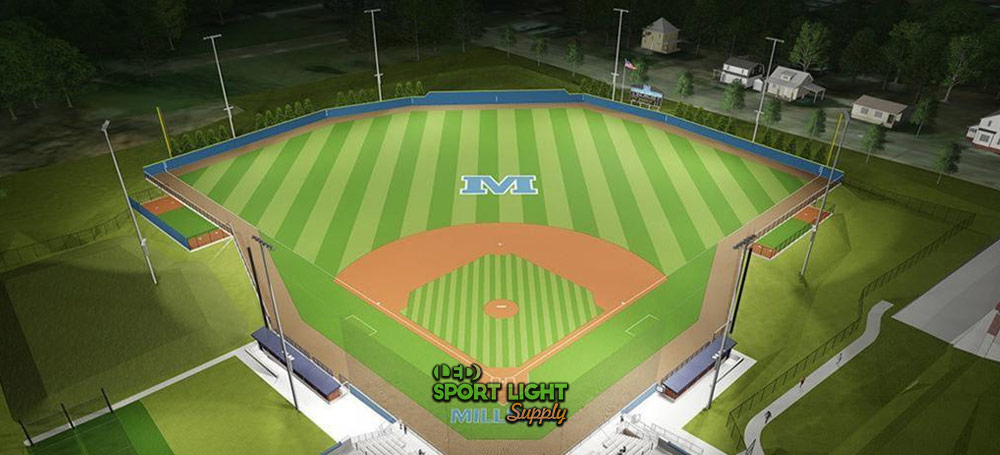
Baseball and softball fields, whether indoor or outdoor, must adhere to specific lighting standards to ensure optimal visibility and safety. The requirements set by organizations like Little League and Major League Baseball (MLB) address various aspects of lighting design. This guide will cover general parameters applicable to both indoor and outdoor fields, including lux levels, lighting uniformity, color temperature, flicker-free lighting, and color rendering indexes.
Lux Requirements
Lux is a unit of measurement used to quantify the intensity of light on a surface. In simple terms, one lux is the illumination produced by a candle placed one meter away from a surface measuring one square meter. To measure lux levels accurately, a lux meter is used. This device provides precise readings of light intensity.
The required lux levels for different purposes are as follows:
| Level of Use | Outfield Lux | Infield Lux |
|---|---|---|
| Training or Recreational Use | 200 to 300 lux | 400 to 600 lux |
| College or High School Games | 500 to 700 lux | 800 to 1000 lux |
| Professional Games (MLB, International Tournaments) | 800 to 1000 lux | 1500 to 2000 lux |
Lighting Uniformity
Uniform light distribution is a crucial characteristic of high-quality floodlights. It’s also an essential standard in lighting design, especially for baseball fields and batting cages, as it helps players detect and avoid obstacles. Uneven lighting can create dark spots, potentially concealing hazards that could lead to injuries.
To ensure proper lighting uniformity, the lighting design grid should be sampled, recording the minimum and maximum lux readings for each section. The average lux value is then calculated. By dividing the minimum lux value by the average lux value, the lighting uniformity ratio is obtained. Design specifications are as follows:
| Level of Use | Uniformity Ratio |
|---|---|
| Training | 0.4 to 0.6 |
| High School Games | 0.5 to 0.6 |
| MLB and International Tournaments | 0.5 to 0.7 |
Color Temperature
Artificial light can be categorized into warm or cool light, with warm light having a yellowish hue and cool light leaning towards blue. The color temperature of light is measured in degrees Kelvin (K).
Kelvin values are typically indicated on the labels of most LED bulbs, providing an idea of the light’s color temperature. Higher Kelvin values correspond to cooler light.
The main color temperatures are:
| Color Temperature | Kelvin Range |
|---|---|
| Warm Light | 2500-3000 K |
| Warm White | 3000-3500 K |
| Neutral White or Natural Daylight Effect | 5000-5500 K |
| Cool White | 5500-6500 K |
Flicker-Free Lights
When recording video in a room illuminated by artificial light, flickering may be noticeable, especially under LED lights. This flicker can be particularly problematic during televised events. Unlike incandescent bulbs, LED lights can exhibit flicker that is detectable by video cameras.
To avoid this issue in broadcasting, it is essential to use flicker-free LED lights. This specification is usually listed in the product details, but if it’s not, it’s advisable to consult the manufacturer before purchasing any LED products intended for high school sports facilities or stadiums.
CRI and TLCI
When observing objects that do not emit their own light, the color you perceive is due to the reflection of light. Your eyes absorb all wavelengths of visible light, and the perceived colors can vary depending on the light source. To evaluate the quality of light, the Color Rendering Index (CRI) is often used.
LED lights typically have a CRI rating between 80 and 95, which is considered good. However, for broadcasting, the Television Lighting Consistency Index (TLCI) provides a more accurate assessment of light quality. A TLCI rating of 90 or higher indicates that the light source is suitable for broadcasting.
Outdoor Lighting Design for the Baseball Diamond
Designing outdoor lighting for a baseball diamond involves several critical factors to ensure optimal visibility, minimize light pollution, and maintain safety. Here’s a detailed guide on key considerations for effective outdoor baseball field lighting.
Light Pollution Control
Light pollution can have significant effects on nearby residential or commercial areas, causing glare and discomfort, and potentially impairing drivers’ vision. To mitigate these issues:
| Feature | Description |
|---|---|
| Shielding | Use shielding on LED light fixtures to direct light precisely where it’s needed and reduce spill light. |
| High Masts and Angles | Install lights on high masts at appropriate vertical angles to focus illumination on the field, minimizing impact on surrounding areas. |
LED lights generally produce less light pollution than other types of lamps due to their directional nature, but their higher intensity can still cause glare if not properly managed.
Flood Light Angle of Projection
The angle of projection for flood lights plays a crucial role in providing effective illumination for both the infield and outfield. For the infield, high mast flood lights typically feature a 25-degree vertical angle. This angle is designed to ensure sufficient vertical illumination, aiding in the visibility of fly balls and enabling players to see clearly. In contrast, flood lights intended for the outfield generally have a 21-degree vertical angle. This angle helps to cover the broader area of the outfield and ensures adequate illumination across the entire field. Proper vertical illuminance is vital for tracking the baseball, particularly when it is airborne, to allow players to react swiftly and safely.
Lightning Protection for High Mast Lighting
Lightning protection is essential for safeguarding high mast lighting systems and preventing damage from electrical surges. To ensure adequate protection, it is important to comply with NFPA 780 standards. This involves proper installation of conductors to safely channel lightning to the ground, correct placement and spacing of ground rods to effectively disperse electrical energy, and the use of surge protectors to protect against voltage spikes and safeguard the stadium’s electrical system. Effective lightning protection not only reduces downtime but also minimizes repair time, ensuring that the lighting system remains operational and safe.
Waterproof Rating of Flood Lights
Outdoor flood and spot lights must be capable of withstanding various weather conditions, and the IP rating (Ingress Protection) provides insight into their durability. The IP rating consists of two digits: the first digit indicates protection against physical objects, with most outdoor fixtures having a rating starting with 6, signifying complete protection against dust. The second digit reflects protection against moisture, with a rating of 6 indicating that the fixture can endure high-pressure water jets. For optimal durability, it is advisable to select LED fixtures with high IP ratings, such as IP67 or IP68. These ratings indicate that the fixtures can operate effectively even when fully immersed in water for up to 30 minutes, ensuring they can withstand adverse weather conditions.
Indoor Lighting Design for Baseball Facilities
Designing indoor lighting for baseball facilities involves addressing specific challenges related to ceiling height, lighting direction, and heat dissipation. Here’s a guide to help you optimize your indoor baseball field lighting.
Ceiling Height
Ceiling height significantly influences the type of lighting required in a facility. For spaces with low ceilings, it is essential to use lights with a larger beam angle to ensure adequate coverage. Since the fixtures are positioned closer to the playing area, a wider beam helps to cover the entire field effectively. Conversely, high ceilings necessitate lights with a smaller beam angle. The increased distance between the light source and the field allows a narrower beam to focus light more precisely where it is needed.
When dealing with curved or sloped ceilings, adjustments to the lighting setup are necessary. For high or curved ceilings, narrow beam spotlights should be used at the center of the ceiling to direct light to specific areas of the field. On the other hand, wider beam fixtures should be positioned around the edges to ensure even illumination and prevent dark spots. Utilizing mounting brackets or frames can help create the necessary spacing and ensure that the lighting design meets standardized requirements.
Direct or Indirect Lighting
When dealing with curved or sloped ceilings, adjustments to the lighting setup are necessary. For high or curved ceilings, narrow beam spotlights should be used at the center of the ceiling to direct light to specific areas of the field. On the other hand, wider beam fixtures should be positioned around the edges to ensure even illumination and prevent dark spots. Utilizing mounting brackets or frames can help create the necessary spacing and ensure that the lighting design meets standardized requirements.
The choice between direct and indirect lighting depends on the specific needs of your facility. Direct lighting involves fixtures aimed directly at the floor, providing focused and uniform illumination. This method offers high lighting uniformity and optimal distribution but can cause glare, which may be distracting or uncomfortable for players and spectators. Indirect lighting, where fixtures are aimed at the ceiling and the light is reflected downward, reduces glare and creates a softer, more diffuse lighting effect. However, it may not achieve the same level of uniformity as direct lighting, and the reflective ceiling must be adequately designed to maximize effectiveness.
Heat Dissipation
Effective heat management is crucial for maintaining the performance and longevity of lighting fixtures. Overheating can reduce efficiency and shorten the lifespan of lights, particularly for LEDs, which are sensitive to excessive heat. To mitigate overheating risks, choose fixtures with efficient heat dissipation systems, such as built-in cooling systems or heat sinks. Additionally, ensure proper ventilation within the facility to avoid trapped hot air that exacerbates overheating issues. Installing a mechanical ventilation heat recovery system can help manage indoor temperatures and improve overall air quality.
Should You Buy Used Baseball Field Lights for Sale?
The decision to buy used baseball field lights involves weighing several factors, including cost, availability, and potential drawbacks. Here’s a closer look at the pros and cons to help you determine if purchasing used lights is the right choice for your facility.
What Are Used Baseball Field Lights?
Used baseball field lights are second-hand LED lights that have been previously installed in baseball fields. These lights become available for resale due to various reasons, such as:
| Scenario | Description |
|---|---|
| Reconstruction or Renovation | When a baseball field undergoes significant changes, existing lights may be removed and replaced. |
| Facility Closure | If a baseball field or sports club shuts down, their lights may be sold. |
| Upgrades | Facilities may upgrade to newer, more advanced lighting technology, making the old lights available for resale. |
Before purchasing used lights, it’s crucial to assess their condition and ensure they meet your needs. Request detailed specifications and test the products if possible.
Advantages and Disadvantages of Buying Used Baseball Field Lights
Cost Savings
One of the most appealing reasons to buy used baseball field lights is the discounted price. These lights are typically sold at a fraction of the cost of new fixtures. This makes them a viable option for facilities on a tight budget. Even though you might need to replace some individual lights, the overall savings can be substantial, especially for complex lighting setups.
Instant Availability
Used lights are often immediately available for purchase, eliminating the long wait times associated with ordering new lights. New fixtures can take weeks or even months to be manufactured and shipped. When buying used, the lights are already packaged and ready to go, which can speed up the installation process. Additionally, some resellers may offer installation services, potentially saving you money on setup.
Disadvantages of Used Baseball Field Lights
Lack of Customization
Customization can be limited with used lights. If your ballpark requires specific lighting configurations, such as precise lumen outputs, beam angles, or color temperatures, used lights might not meet these needs. Custom modifications and accessories that can be included with new lights, like calibrated beam angles and pre-installed shielding, may not be available with used options.
Unknown Lifespan
The unknown lifespan of used lights is a significant concern. LED lights degrade over time, and their efficiency, color rendering ability, and overall performance can diminish with continued use. Without knowing the number of hours the lights have been used, you might end up with fixtures that have a shorter lifespan than expected. This could result in additional costs for replacement or maintenance.
Warranty Issues
Warranty concerns are another downside. Used lights may come with limited or expired warranties, making repairs potentially costly. If the lights fail, finding parts or services for older models can be challenging and expensive. Be cautious when purchasing used lights, especially if they are older or have been discontinued.
How to Select the Best Baseball Field Lighting Companies
Choosing the right baseball field lighting company is crucial for ensuring optimal lighting and a smooth installation process. While online reviews can provide some insight, they don’t always reveal the full picture. Here’s a guide to evaluating and selecting the best lighting company based on key aspects.
Expertise
When selecting a company for baseball field lighting, it is essential to start by evaluating their experience and knowledge in the field. Consider the company’s track record, including details about their past projects and client list. A reputable company should be open to sharing examples of their previous work and providing references from past clients. This transparency helps in assessing their capability and reliability.
Next, ensure that the company demonstrates technical proficiency in modern lighting technology and techniques. They should be well-versed in the latest innovations and trends in sports lighting. It is beneficial to check whether the company offers specialized training or certifications for their team, which indicates a commitment to staying current with advancements in the industry.
Seek out companies that offer customized lighting solutions tailored to your specific requirements. This might involve detailed lighting design services, such as DIALux simulations, to determine the optimal number of lights, beam angles, and power requirements for your project. Custom solutions ensure that the lighting is designed to meet your unique needs effectively.
Price
If a company provides LED lights at prices significantly below industry standards, such as less than $0.4 per watt, this could be a red flag indicating that the products are either subpar or reconditioned. High-quality lighting systems generally come at a price that reflects the quality of materials, technology, and craftsmanship involved.
Moreover, always request detailed quotes from the companies you are considering. A comprehensive quote should include specifications and a breakdown of costs, helping you understand what you are paying for and uncovering any potential hidden fees. While comparing prices is important, remember that the lowest price does not always equate to the best value. Investing in quality lighting often requires a balance between cost and performance to ensure a satisfactory outcome.
Lighting Design and Customization
A high-quality lighting company should offer comprehensive design services, including custom lighting plans and simulations. These services ensure that the lighting will meet your specific needs. For example, check if the company provides tools like DIALux simulations, which help visualize the lighting setup and assess its effectiveness before implementation.
Evaluate the company’s flexibility in providing tailored solutions. Some companies might offer only standard packages, which may not perfectly suit your requirements. A reputable company should be capable of adjusting their offerings to accommodate the unique specifications of your field. This flexibility is crucial for achieving an optimal lighting setup that addresses your specific needs and enhances the performance of your facility.
Research and Development (R&D)
When selecting a lighting company, consider their commitment to innovation and improvement. A leading company should invest in research and development (R&D) to continually enhance their products. Look for signs that the company is actively involved in R&D activities, such as partnerships with universities or participation in industry research projects. This involvement indicates a dedication to advancing lighting technology and staying ahead of industry trends.
Assess whether the company is engaged in developing new lighting technologies or solutions. Their commitment to innovation will be reflected in the quality and efficiency of their products. Companies that prioritize up-to-date technology are more likely to offer advanced, high-performance lighting solutions that meet modern standards and deliver superior results.
Warranty
A robust warranty is a strong indicator of the company’s confidence in the quality of their products. Look for companies that provide warranties in the range of 5 to 10 years, which is consistent with the typical lifespan of high-quality LED lights. This duration reflects a reasonable expectation of the product’s durability and performance.
Be cautious of warranties that are either too short or excessively long. Warranties of only 1 to 2 years may suggest that the product has limited longevity, indicating potential concerns about its durability. On the other hand, warranties extending beyond 30 years might be more of a sales tactic than a genuine assurance of quality. Evaluating warranty terms within a reasonable range helps ensure that you are investing in reliable and high-quality lighting solutions.
Customer Service
Before placing an order, test how quickly and effectively the company responds to your questions or concerns. A reliable company should demonstrate prompt, helpful, and accurate customer service, reflecting their commitment to addressing client needs efficiently.
Consider the quality of the company’s service, particularly in how they handle issues and provide solutions. Effective communication and problem-solving are crucial for ensuring a smooth installation process and achieving long-term satisfaction with your lighting system. A company that excels in these areas will help mitigate any challenges that may arise during or after installation.
Ensure that the company offers ongoing support and maintenance services if needed. Having access to reliable support after installation is important for addressing any issues that may come up, ensuring the continued performance and reliability of your lighting system.
Baseball Field Lighting FAQ
How much does it cost to buy baseball field lights?
The cost of purchasing baseball field lights can range from $10,000 to $120,000. This wide range depends on several factors, including the level of competition, field size, light pole layout and height, and specific technical requirements. For example, indoor softball facilities might require more lights due to the multi-purpose nature of the pitches. Additionally, you might need to consider secondary lighting solutions, such as movable light towers or lighting for adjacent areas like batting cages. For an accurate price, it’s best to request a detailed quote that includes all necessary components and services.
How much does it cost to run baseball and softball stadium lighting?
Running costs for baseball and softball stadium lighting are influenced by the type of light fixtures used. On average, you can expect to spend between $6 and $60 per 10,000 watts per hour. LED lights, known for their energy efficiency, can significantly reduce operating costs compared to traditional lighting options. For example, a baseball field that requires 50,000 watts of LED lighting might consume 150,000 to 250,000 watts if using metal halide lights, or up to 500,000 watts with halogen lamps to achieve the same brightness. Switching to LED lights can lead to substantial savings on electricity bills.
What are baseball field lighting grants or funding?
Funding opportunities for baseball field lighting renovations can come from national or international sources. Baseball clubs or associations can often apply for grants from foundations or local committees. Non-governmental organizations (NGOs) may also seek free lighting design or supply through sponsorships. However, some funding programs may not cover operational costs, salaries, or marketing expenses, so it’s important to review eligibility criteria and terms carefully.
Public financing for professional baseball stadiums can also be available, usually managed by budget offices that evaluate proposals. To improve your chances, consider creating a modular funding project where lighting equipment is purchased and installed in phases. Be aware of fiscal and judicial duties associated with public funding, as these can vary by region and project.
How to select the best baseball field lights?
When choosing the best lighting for your baseball facility, consider the following factors:
Luminous Efficacy Look for lights with high lumens per watt ratios to ensure efficient illumination. LED lighting is typically the most effective, offering high luminous flux with minimal energy loss and heat production. This efficiency translates into lower energy consumption and reduced environmental impact.
Beam Angle Select lights with the appropriate beam angle for your needs. Wide-angle flood lights are generally preferred for baseball fields to cover larger areas, while narrow-angle spot lights may be used for specific purposes. Consult with a lighting designer to determine the best layout and beam angle for your field.
Color Temperature For optimal performance, choose lights with a natural daylight color temperature of around 5,500 K. This temperature is preferred by players for its clarity and visibility. Adjust color temperature if needed based on the time of day or weather conditions to enhance performance.
Life Span LED lights offer the longest life span compared to other types. They efficiently transfer heat through a heat sink, which helps to extend their operational life. Consider lights with features like light sensors that activate the lights only when necessary to further improve their longevity.
Flicker-Free If your field will be used for broadcasting or recording, ensure the lights are flicker-free. Look for specific certifications or ask the manufacturer to confirm this feature. A good warranty should cover any issues related to flicker.
Glare Minimize glare by choosing lights with low to moderate glare levels and ensuring proper pole height. Proper design and installation are crucial to avoid excessive glare that can affect players and spectators. If glare is an issue, consider installing shielding or accessories to mitigate the problem.
Warranty Opt for lights with a warranty of 5 to 10 years. Ensure that the installation complies with relevant regulations and standards, such as those set by the Little League or Major League Baseball, to meet official event requirements. Proper documentation of the installation and adherence to standards are essential for managing high school or college sports facilities.
Conclusion
Setting up lighting for baseball and softball fields can indeed be a complex task, but this guide has aimed to simplify the process by covering both fundamental and advanced concepts. From understanding the costs and running expenses to selecting the right fixtures and ensuring compliance with regulations, you now have a comprehensive overview of what is required to effectively illuminate a baseball diamond.
Armed with this information, you should feel more confident in your ability to choose and implement the best stadium LED lights for your facility. With a solid grasp of the primary standards and considerations, you can now focus on additional details and specific requirements with greater ease. Whether you’re upgrading existing lighting or starting a new project, this guide provides the insights needed to make informed decisions and ensure optimal lighting for your baseball or softball field.
